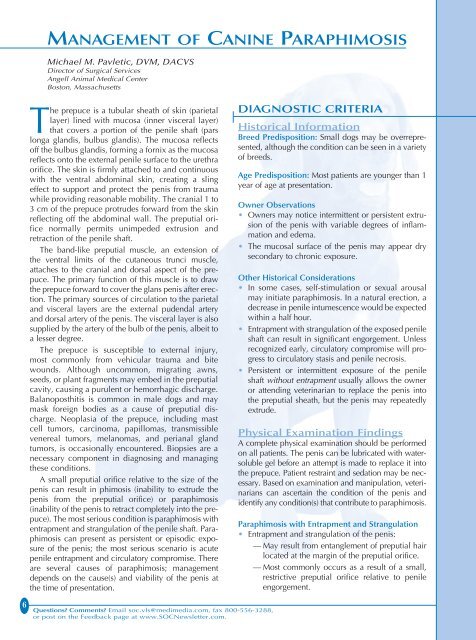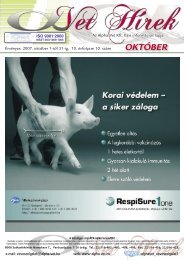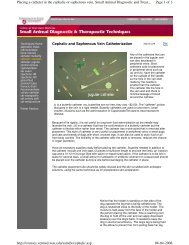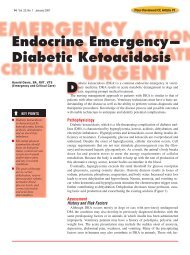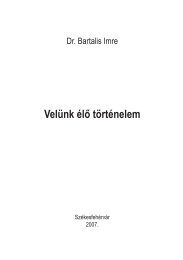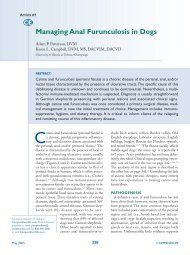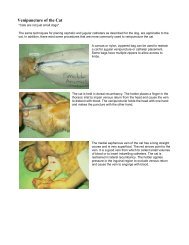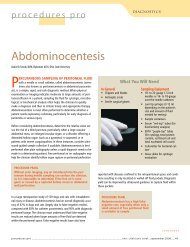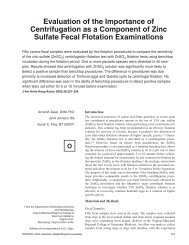MANAGEMENT OF CANINE PARAPHIMOSIS - Hungarovet
MANAGEMENT OF CANINE PARAPHIMOSIS - Hungarovet
MANAGEMENT OF CANINE PARAPHIMOSIS - Hungarovet
You also want an ePaper? Increase the reach of your titles
YUMPU automatically turns print PDFs into web optimized ePapers that Google loves.
6<br />
<strong>MANAGEMENT</strong> <strong>OF</strong> <strong>CANINE</strong> <strong>PARAPHIMOSIS</strong><br />
Michael M. Pavletic, DVM, DACVS<br />
Director of Surgical Services<br />
Angell Animal Medical Center<br />
Boston, Massachusetts<br />
The prepuce is a tubular sheath of skin (parietal<br />
layer) lined with mucosa (inner visceral layer)<br />
that covers a portion of the penile shaft (pars<br />
longa glandis, bulbus glandis). The mucosa reflects<br />
off the bulbus glandis, forming a fornix as the mucosa<br />
reflects onto the external penile surface to the urethra<br />
orifice. The skin is firmly attached to and continuous<br />
with the ventral abdominal skin, creating a sling<br />
effect to support and protect the penis from trauma<br />
while providing reasonable mobility. The cranial 1 to<br />
3 cm of the prepuce protrudes forward from the skin<br />
reflecting off the abdominal wall. The preputial orifice<br />
normally permits unimpeded extrusion and<br />
retraction of the penile shaft.<br />
The band-like preputial muscle, an extension of<br />
the ventral limits of the cutaneous trunci muscle,<br />
attaches to the cranial and dorsal aspect of the prepuce.<br />
The primary function of this muscle is to draw<br />
the prepuce forward to cover the glans penis after erection.<br />
The primary sources of circulation to the parietal<br />
and visceral layers are the external pudendal artery<br />
and dorsal artery of the penis. The visceral layer is also<br />
supplied by the artery of the bulb of the penis, albeit to<br />
a lesser degree.<br />
The prepuce is susceptible to external injury,<br />
most commonly from vehicular trauma and bite<br />
wounds. Although uncommon, migrating awns,<br />
seeds, or plant fragments may embed in the preputial<br />
cavity, causing a purulent or hemorrhagic discharge.<br />
Balanoposthitis is common in male dogs and may<br />
mask foreign bodies as a cause of preputial discharge.<br />
Neoplasia of the prepuce, including mast<br />
cell tumors, carcinoma, papillomas, transmissible<br />
venereal tumors, melanomas, and perianal gland<br />
tumors, is occasionally encountered. Biopsies are a<br />
necessary component in diagnosing and managing<br />
these conditions.<br />
A small preputial orifice relative to the size of the<br />
penis can result in phimosis (inability to extrude the<br />
penis from the preputial orifice) or paraphimosis<br />
(inability of the penis to retract completely into the prepuce).<br />
The most serious condition is paraphimosis with<br />
entrapment and strangulation of the penile shaft. Paraphimosis<br />
can present as persistent or episodic exposure<br />
of the penis; the most serious scenario is acute<br />
penile entrapment and circulatory compromise. There<br />
are several causes of paraphimosis; management<br />
depends on the cause(s) and viability of the penis at<br />
the time of presentation.<br />
Questions? Comments? Email soc.vls@medimedia.com, fax 800-556-3288,<br />
or post on the Feedback page at www.SOCNewsletter.com.<br />
DIAGNOSTIC CRITERIA<br />
Historical Information<br />
Breed Predisposition: Small dogs may be overrepresented,<br />
although the condition can be seen in a variety<br />
of breeds.<br />
Age Predisposition: Most patients are younger than 1<br />
year of age at presentation.<br />
Owner Observations<br />
• Owners may notice intermittent or persistent extrusion<br />
of the penis with variable degrees of inflammation<br />
and edema.<br />
• The mucosal surface of the penis may appear dry<br />
secondary to chronic exposure.<br />
Other Historical Considerations<br />
• In some cases, self-stimulation or sexual arousal<br />
may initiate paraphimosis. In a natural erection, a<br />
decrease in penile intumescence would be expected<br />
within a half hour.<br />
• Entrapment with strangulation of the exposed penile<br />
shaft can result in significant engorgement. Unless<br />
recognized early, circulatory compromise will progress<br />
to circulatory stasis and penile necrosis.<br />
• Persistent or intermittent exposure of the penile<br />
shaft without entrapment usually allows the owner<br />
or attending veterinarian to replace the penis into<br />
the preputial sheath, but the penis may repeatedly<br />
extrude.<br />
Physical Examination Findings<br />
A complete physical examination should be performed<br />
on all patients. The penis can be lubricated with watersoluble<br />
gel before an attempt is made to replace it into<br />
the prepuce. Patient restraint and sedation may be necessary.<br />
Based on examination and manipulation, veterinarians<br />
can ascertain the condition of the penis and<br />
identify any condition(s) that contribute to paraphimosis.<br />
Paraphimosis with Entrapment and Strangulation<br />
• Entrapment and strangulation of the penis:<br />
— May result from entanglement of preputial hair<br />
located at the margin of the preputial orifice.<br />
— Most commonly occurs as a result of a small,<br />
restrictive preputial orifice relative to penile<br />
engorgement.
— Causes dramatic swelling and edema of the<br />
exposed penis; close examination reveals a<br />
“napkin ring” or banding effect created by the<br />
preputial orifice. The exposed penile segment<br />
can be two or three times its normal size.<br />
• Prolonged entrapment and strangulation causes<br />
venous and lymphatic compromise; severe circulatory<br />
compromise leads to penile necrosis. The<br />
penile shaft may be deep purple to black. Occasionally,<br />
early or partial circulatory compromise<br />
may result in pale, patchy mucosal discoloration<br />
and necrosis of the external penile mucosa.<br />
• Affected patients have pain and may resist manipulation<br />
of the area. Patients often lick at the exposed<br />
penis constantly.<br />
Paraphimosis without Entrapment/Strangulation<br />
• Patients presenting with paraphimosis without<br />
entrapment and strangulation may have a history of<br />
intermittent or persistent penile extrusion.<br />
• In most cases, the exposed penis may be pushed<br />
back into the prepuce, facilitated by the use of a<br />
water-soluble lubricant.<br />
• Chronic exposure of the penis results in drying of<br />
the mucosal surface and loss of normal mucosal<br />
lubrication. A small preputial orifice may impair<br />
normal retraction of the penile shaft. When it contacts<br />
the neighboring skin around the preputial orifice,<br />
the penis will “drag” the skin inward,<br />
preventing its normal withdrawal into the prepuce.<br />
This may be the sole cause of paraphimosis or a<br />
contributing factor secondary to the presence of a<br />
small preputial orifice.<br />
• In some cases, intermittent or persistent exposure of<br />
the penile shaft may be the result of a penile length<br />
disparity relative to the prepuce. The preputial orifice<br />
appears normal in diameter with normal elasticity.<br />
• Patients may be uncomfortable but lack the overt<br />
signs of pain displayed with penile entrapment and<br />
strangulation.<br />
• Paraphimosis may be acquired secondary to pelvic<br />
or local abdominal trauma. Although uncommon,<br />
regional scar tissue formation can impair preputial<br />
mobility. Similarly, injury to the preputial muscles<br />
could impair the forward advancement of the prepuce<br />
over the penis after erection, but this has not<br />
been documented.<br />
Laboratory Findings<br />
• There are no laboratory findings specific to paraphimosis.<br />
• A stress leukogram or neutrophilia may be noted with<br />
the presence of penile entrapment/strangulation. $<br />
• A complete blood count and serum chemistry profile<br />
may be advisable for sick patients or as a nor-<br />
STANDARDS of CARE: EMERGENCY AND CRITICAL CARE MEDICINE<br />
mal preoperative screen for patients older than 5<br />
years of age. $<br />
• Presurgical screening (hematocrit, total solids,<br />
blood glucose, creatinine, total leukocyte count)<br />
may be advisable for healthy patients younger than<br />
5 years of age. $<br />
Summary of Diagnostic Criteria<br />
• Paraphimosis is most commonly seen in dogs<br />
younger than 1 year of age; small-breed dogs may<br />
be overrepresented.<br />
• Diagnosis is primarily determined by physical<br />
examination of the prepuce and penis at the time of<br />
hospitalization.<br />
• Before examination, the patient’s history can help<br />
determine whether paraphimosis is intermittent or<br />
persistent.<br />
• Paraphimosis with entrapment and strangulation<br />
results in dramatic swelling of the exposed penis.<br />
Immediate attempts to correct this condition are<br />
indicated. Entrapment is most commonly associated<br />
with restriction around the penis from a small<br />
preputial orifice relative to the diameter of the<br />
penile shaft. Although rare, long preputial hair<br />
strands also can result in a similar condition.<br />
• Paraphimosis without entrapment or strangulation<br />
may be the result of penile mucosal desiccation<br />
causing a “friction effect” with the adjacent preputial<br />
skin, thereby impeding retraction; a small preputial<br />
orifice may contribute to this condition. In some<br />
patients, the penis may have insufficient coverage<br />
because of a disparity in the length of the prepuce.<br />
• Paraphimosis may be acquired, secondary to<br />
regional scarring following surgery, or the result of<br />
trauma.<br />
Differential Diagnosis<br />
• Priapism (persistent erection) unassociated with<br />
sexual excitement is usually the result of spinal<br />
cord injury, although it has been described in association<br />
with constipation or genitourinary infection.<br />
Priapism is considered a very rare disorder in<br />
small animals.<br />
• Penile trauma may result in swelling with exteriorization<br />
of variable portions of the shaft. Bite wounds<br />
or external abrasions to the penis, prepuce, and<br />
lower abdomen secondary to vehicular trauma may<br />
be noted. Careful manipulation of the penis with supportive<br />
radiography helps determine the presence of<br />
a fracture to the os penis. In most cases, the preputial<br />
orifice is not involved in penile entrapment.<br />
• Neoplasia may result in restriction of the preputial<br />
orifice and contribute to the development of paraphimosis.<br />
(More commonly, neoplasia restricts extrusion<br />
of the penile shaft.)<br />
7
8<br />
TREATMENT<br />
RECOMMENDATIONS<br />
Initial Treatment<br />
Paraphimosis with Entrapment/Strangulation<br />
Emergency tension-relieving (release) incision: $ With<br />
strangulation or entrapment, a tension-release incision<br />
is the single most effective technique to immediately<br />
relieve circumferential tension on the penile shaft.<br />
Thereafter, topical care can be instituted.<br />
The most accessible site for enlarging the preputial<br />
orifice is along its ventral border. A #10 or #15 scalpel<br />
blade or a sharp pair of blunt-tipped scissors may be<br />
used to incise the border sufficiently to relieve the circumferential<br />
tension. The lubricated surface of a Bard-<br />
Parker scalpel handle may be partially inserted<br />
between the prepuce and penis before incising the area<br />
to avoid injury to the penile shaft. Bleeding is usually<br />
minimal.<br />
• If entanglement of preputial hair is the cause of<br />
strangulation, the hair fibers should be cut.<br />
• Sedation or general anesthesia is recommended; no<br />
food or water should be provided on admitting the<br />
patient if anesthesia is anticipated.<br />
• If feasible, the penis should be replaced into the<br />
preputial cavity. Topical ointment should be applied<br />
to prevent desiccation of the exposed penile mucosa.<br />
• Analgesics are advisable.<br />
• An intravenous line should be established for rapid<br />
administration of medications and necessary fluid<br />
therapy.<br />
• The size of the urinary bladder should be assessed;<br />
if urethral obstruction secondary to penile swelling<br />
and constriction occurs, catheterization is warranted.<br />
Alternatively, a cystostomy tube may be<br />
considered if severe swelling precludes urethral<br />
catheterization.<br />
• If the penis is clearly necrotic, penile amputation<br />
should be performed. $$$$<br />
Paraphimosis without Entrapment/Strangulation<br />
• The preputial orifice should be examined to determine<br />
if the opening restricts normal passage of the<br />
penile shaft.<br />
• Water-soluble lubricant should be applied to the<br />
exposed penis, which can then be gently manipulated<br />
back into the preputial orifice.<br />
• Sedation may be necessary for agitated patients.<br />
Alternative/Optional Treatments<br />
Paraphimosis with Entrapment/Strangulation<br />
• In conjunction with the preputial release incision,<br />
application of 50% dextrose topically, as a hyperosmotic<br />
agent, may help to reduce penile edema.<br />
S E P T E M B E R 2 0 0 5 V O L U M E 7 . 8<br />
KEY POINTS IN PREPUTIAL<br />
ADVANCEMENT SURGERY<br />
• Position the patient properly: With the patient in<br />
dorsal recumbency, position the rear limbs to<br />
maximize penile exposure. This helps ensure<br />
appropriate cranial advancement of the prepuce.<br />
• After creating a “U” incision cranial to the<br />
prepuce, undermine the prepuce from the<br />
underlying abdominal wall. Attempt to advance<br />
(stretch) the prepuce (using skin hooks or stay<br />
sutures) sufficiently to ensure complete coverage<br />
of the penis. The incisions can be extended<br />
parallel to prepuce and penis incrementally as<br />
needed. The penis should be completely covered.<br />
• Note that the preputial incisions can be extended<br />
caudally beyond the level of the preputial fornix if<br />
necessary to optimize its forward advancement.<br />
• The point of cranial advancement corresponds<br />
to complete coverage of the penile tip (see<br />
Alternative/Optional Treatments). Mark the point<br />
of desired advancement on the skin with a sterile<br />
marking pen or a nick with the scalpel blade.<br />
Remove the interposing skin between this point<br />
and the cranial preputial incision.<br />
• It is critical to suture the cranial dermal border of<br />
the prepuce to the external abdominal oblique<br />
muscle fascia (linea) at the advancement point.<br />
This is necessary to prevent elastic retraction of<br />
the prepuce and stretching of the skin anterior to<br />
the point of advancement. Place four to six<br />
nonabsorbable sutures (monofilament nylon or<br />
Prolene); 3-0 suture material may be used in most<br />
cases, except for small dogs with very thin skin, in<br />
which 4-0 suture material is preferable.<br />
• Simple interrupted skin sutures are used to close<br />
the skin incision.<br />
• Common problems leading to failure include:<br />
—Failure to aggressively advance the prepuce.<br />
—Improper positioning of the patient before surgery.<br />
—Failure to secure the preputial border to the<br />
external abdominal oblique fascia with<br />
nonabsorbable intradermal sutures.<br />
Gauze soaked with 50% dextrose can be gently<br />
wrapped around the penis to maintain contact.<br />
Dextrose should be reapplied in small amounts<br />
every few hours.<br />
• An Elizabethan collar is likely needed to prevent the<br />
dog from licking the exposed penis.<br />
• Although their efficacy in reducing swelling may be<br />
controversial, systemic corticosteroids or NSAIDs<br />
may be considered.<br />
• If the entrapped penile segment is necrotic, partial<br />
penile amputation should be performed. $$$$<br />
• With successful resolution, permanent enlargement of<br />
the preputial orifice can be performed dorsally. (An
emergency tension-relieving preputial incision may<br />
heal without creating a permanent enlargement.)<br />
• Surgical reduction of the prepuce after penile<br />
amputation is unnecessary, based on my clinical<br />
experience to date.<br />
Paraphimosis without Entrapment/Strangulation<br />
Topical Antibiotic Ointment $<br />
Topical ointments lubricate the penile shaft and help<br />
facilitate its examination and retraction into the prepuce.<br />
In some patients, this conservative approach can<br />
resolve mild cases of paraphimosis secondary to exposure<br />
desiccation with an otherwise normal prepuce.<br />
Topical antibiotic ointment (with a stem-tipped<br />
applicator), with or without topical corticosteroids, can<br />
be infused in small amounts into the prepuce two or<br />
three times daily for 1 month. The prepuce should be<br />
massaged lightly to promote distribution. The ointment<br />
can maintain moisture and promote healing of the<br />
damaged penile mucosal surface. Owners should be<br />
instructed to examine the area periodically and replace<br />
the penis if it extrudes from the preputial orifice.<br />
Enlarging the Preputial Orifice $$<br />
If a small preputial orifice is a contributing cause, it<br />
can be enlarged with a dorsal incision. Hemostats can<br />
be inserted and opened in the orifice to ensure that the<br />
incision sufficiently enlarges the preputial opening (by<br />
releasing the constricting “band”). The skin is apposed<br />
to the mucosa with 4-0 absorbable interrupted sutures,<br />
thereby creating a permanent V-shaped notch in the<br />
orifice.<br />
Preputial Advancement $$$–$$$$<br />
Preputial advancement (see box on page 8) can be performed<br />
to correct penile exposure due to a lack of<br />
preputial coverage. If additional coverage is required<br />
after advancement, the ventral preputial orifice can be<br />
partially closed, followed by reciprocal enlargement of<br />
the dorsal orifice border. This technique is the preferred<br />
method to correct most cases of persistent penile<br />
exposure (intermittent or continuous) unresponsive to<br />
conservative topical therapy and penile replacement.<br />
The technique can also be used to manage paraphimosis<br />
secondary to scarring caused by trauma or<br />
surgery. During elevation of the prepuce, scar bands<br />
are divided to facilitate relocation of the prepuce cranial<br />
to its original position.<br />
Supportive Treatment<br />
Paraphimosis with Entrapment/Strangulation<br />
• Intravenous catheter placement and administration<br />
of intravenous fluids.<br />
• Urinary catheter placement or the use of a cystostomy<br />
tube in cases of urethral obstruction.<br />
STANDARDS of CARE: EMERGENCY AND CRITICAL CARE MEDICINE<br />
CHECKPOINTS<br />
— There are a few basic causes of<br />
paraphimosis, including small preputial<br />
orifice (congenital or acquired), preputial<br />
length disparity in relation to the penis, hair<br />
encirclement of the exposed penile shaft,<br />
penile mucosal exposure, scar tissue<br />
secondary to surgery or trauma restricting<br />
preputial coverage, and desiccation causing<br />
frictional drag on the skin surrounding the<br />
orifice. Treatment is dictated by the<br />
cause(s), severity of penile injury, and<br />
response to therapy. In my clinical<br />
experience, shortening or imbricating the<br />
preputial muscles is usually unnecessary in<br />
the treatment of paraphimosis.<br />
• The exposed penis can be covered with gauze saturated<br />
with 50% dextrose solution to facilitate reduction<br />
of tissue edema. Cold compresses may be<br />
beneficial. Otherwise, any exposed penile segment<br />
may be covered with moistened (isotonic solutions)<br />
gauze sponges to prevent further tissue desiccation.<br />
• On occasion, pale, patchy areas of mucosal necrosis<br />
may be noted over the penile surface. Many of<br />
these areas will heal by second intention within 1<br />
month. A topical antibiotic ointment may be used<br />
to promote healing, as discussed previously.<br />
• An Elizabethan collar is indicated to prevent licking<br />
and self-mutilation.<br />
Paraphimosis without Entrapment/Strangulation<br />
• With successful replacement of the penis in a<br />
patient with an otherwise normal prepuce, topical<br />
ointment (as discussed previously) is used to promote<br />
healing of the desiccated penile mucosa.<br />
• Enlargement of the preputial orifice requires no<br />
basic postoperative care.<br />
• With preputial advancement surgery, the patient<br />
should be hospitalized for at least 24 hours to determine<br />
if complete coverage of the penis has been<br />
achieved.<br />
• An Elizabethan collar is indicated to prevent licking<br />
and self-mutilation.<br />
Patient Monitoring<br />
Paraphimosis with Entrapment/Strangulation<br />
• The potential viability of the penis should be<br />
assessed in the days following initial therapy: The<br />
viability of an entrapped penis may not be readily<br />
evident at the time of presentation. Necrosis normally<br />
is characterized by a deep purple to black<br />
appearance of the entrapped penile segment; partial<br />
penile amputation is required. $$$$<br />
9
10<br />
• The patient’s ability to urinate should be closely<br />
assessed; catheterization and use of a closed collection<br />
system is indicated in patients with urethral<br />
obstruction secondary to penile swelling.<br />
Paraphimosis without Entrapment/Strangulation<br />
• If conservative management using ointments was<br />
instituted, the penile coverage should be assessed<br />
periodically throughout the day; owners should be<br />
instructed to replace an exposed penis into the<br />
preputial cavity.<br />
• If preputial advancement fails to fully cover the penis,<br />
readvancement of the prepuce should be considered.<br />
Partial ventral closure, with a reciprocal enlargement<br />
of the dorsal orifice, also may be considered.<br />
• In the event of incomplete coverage in the most<br />
problematic cases, reconstructive surgery or partial<br />
penile amputation can be considered. $$$$<br />
Home Management<br />
• Patients normally are discharged when swelling<br />
resolves and the viable penis has been replaced into<br />
the preputial cavity.<br />
• If preputial hair was the cause of paraphimosis,<br />
owners should be instructed to keep the hair<br />
trimmed from the preputial orifice.<br />
• With partial penile amputation, dogs normally are<br />
sent home 3 to 5 days after surgery, depending on<br />
the degree of postoperative bleeding; patients can<br />
be sent home once bleeding is minimal and urination<br />
is normal.<br />
• Owners should be instructed to watch their pet’s<br />
urination and to contact their veterinarian immediately<br />
if straining or the inability to urinate is noted.<br />
• Owners should examine the preputial area several<br />
times daily to ensure penile coverage is maintained.<br />
• Dogs should be kept away from any sexual stimulation<br />
(e.g., bitches in heat) during the recovery period.<br />
• Dogs that excessively lick themselves because of<br />
penile trauma may cause engorgement through selfstimulation<br />
and may need to be given tranquilizers<br />
or mild sedation for several days following penile<br />
replacement.<br />
• If topical ointments are being used, small amounts<br />
should be infused into the prepuce, which should<br />
then be massaged slightly to ensure distribution. The<br />
penis should be extruded and the mucosa examined<br />
on a weekly basis. Conservative therapy can be continued<br />
for 2 to 4 weeks. Note: Recurrent exposure<br />
despite therapy normally requires corrective surgery.<br />
• An Elizabethan collar is recommended to prevent<br />
the patient from licking the prepuce and penis.<br />
• Owners are advised to restrict the patient’s activity<br />
for a month.<br />
S E P T E M B E R 2 0 0 5 V O L U M E 7 . 8<br />
Milestones/Recovery<br />
Time Frames<br />
• If the penis is viable, penile swelling and edema<br />
should subside significantly within a few days after<br />
incising the preputial band and instituting medical<br />
management.<br />
• Resumption of normal urination.<br />
• Resolution of bleeding after partial penile amputation;<br />
healing of the surgical site.<br />
• Healing of external penile mucosal defects in a<br />
patient with an otherwise viable penile shaft.<br />
• Ability of the penis to be extruded for examination<br />
and then spontaneously retract into the preputial<br />
orifice.<br />
• Complete penile coverage following preputial<br />
advancement.<br />
• After enlargement of the preputial orifice, healing of<br />
the V-shaped notch, located at the dorsal preputial<br />
border, should be complete in 10 to 14 days.<br />
Treatment Contraindications<br />
Amputation of an otherwise viable penis is not considered<br />
a primary management option for paraphimosis.<br />
Corrective preputial surgery normally provides reasonable<br />
coverage and restoration of function.<br />
PROGNOSIS<br />
Favorable Criteria<br />
• Viable penile tissue.<br />
• Complete healing of the surgical sites.<br />
• Normal urination.<br />
• Complete penile coverage.<br />
• Normal egress and ingress of the penile shaft with<br />
the prepuce.<br />
Unfavorable Criteria<br />
• Complete necrosis of penile tissue; amputation.<br />
• Persistent exposure of the penis or incomplete<br />
preputial coverage.<br />
• Wound dehiscence.<br />
• Tissue infection.<br />
• Inability to urinate as a result of urethral compression<br />
and/or edema without catheter or cystostomy<br />
tube insertion.<br />
• Urinary tract infection.<br />
RECOMMENDED READING<br />
Boothe HW: Penis, prepuce, and scrotum, in Slatter D (ed):<br />
Textbook of Small Animal Surgery, ed 3. Philadelphia, WB<br />
Saunders, 2003, pp 1532–1541.<br />
Fossum TW: Small Animal Surgery, ed 2. Philadelphia, Mosby,<br />
2002, pp 666–674.


